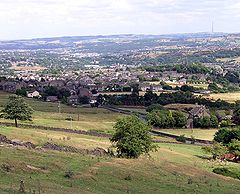Golcar
| Golcar | |
|---|---|
 Golcar Village |
|
| Golcar shown within West Yorkshire | |
| Population | 17,000 (2001) |
| OS grid reference | SE1020015735 |
| District | |
| Shire county | |
| Region | |
| Country | England |
| Sovereign state | United Kingdom |
| Post town | HUDDERSFIELD |
| Postcode district | HD7 |
| Dialling code | 01484 |
| Police | West Yorkshire |
| Fire | West Yorkshire |
| Ambulance | Yorkshire |
| EU Parliament | Yorkshire and the Humber |
| UK Parliament | |
Golcar (pronounced 'Goker' or 'Golker': the 'L' is silent in local pronunciation) is a village located on a hillside crest above the Colne Valley in West Yorkshire, England, 2.5 miles (4 km) west of Huddersfield, and just north of the River Colne and the Huddersfield Narrow Canal. By the time of the 2011 Census the population had increased to 18,033. The main access route is from the A62 (Manchester Road), through Milnsbridge in the bottom of the valley or via Scapegoat Hill from the A640 (New Hey Road) at the top of the hill.
When it was a Township, Golcar consisted of Bolster Moor, Golcar, Leymoor, Pole Moor, Scapegoat Hill and Town End.
Golcar is a relatively small village, but it has a long history. Named after St Guthlac, who preached in the area during the 8th century, its name is recorded in the Domesday Book as Goullakarres. During the Industrial Revolution Golcar became an important centre for weaving. Internationally renowned pharmacologist James Burrows grew up in the area.
Three former 1840s weavers' cottages were converted, in 1970, into the Colne Valley Museum. The museum features several restored period rooms which are used to show temporary exhibitions. The museum was further extended in 2008 following the purchase of the adjoining former fish and chip shop.
Exhibits include a handloom and a spinning jenny, invented by James Hargreaves. In the loom chamber, spinning room, weavers sitting room and 'gas-lit' cloggers shop, the volunteer helpers give regular demonstrations of the type of crafts that would have existed during the nineteenth century.
...
Wikipedia

